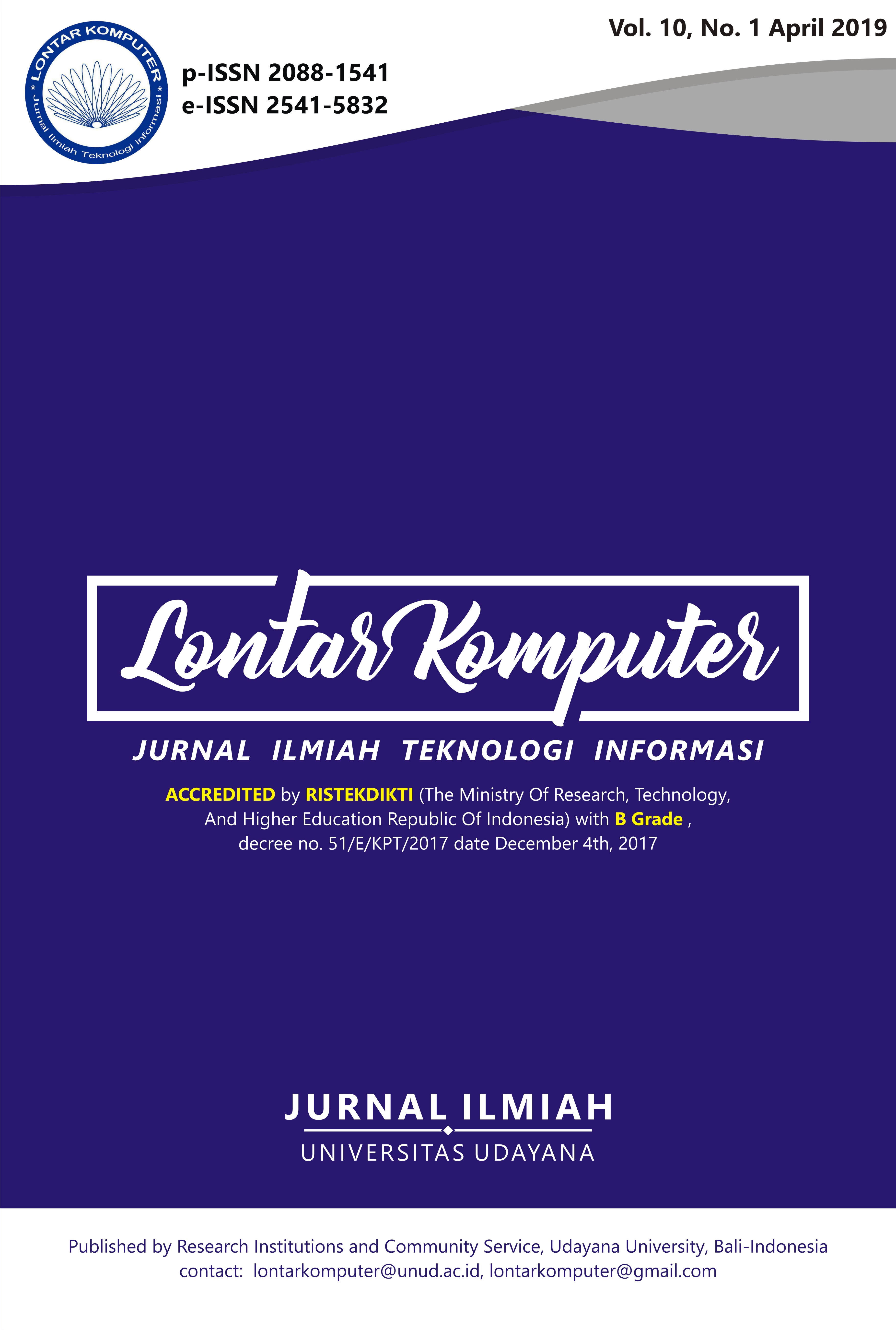Implementation of Zoning and K-Nearest Neighbor in Character Recognition of Wrésastra Script
Abstract
Balinese script is an important aspect that packs the Balinese culture from time to time which continues to experience development along with technological advances. Balinese script consists of three types (1) Wrésastra, (2) Swalalita and (3) Modre which have different types of characters. The Wrésastra and Swalalita script are Balinese scripts which grouped into the script criteria that are used to write in the field of everyday life. In this research, the zoning method will be implemented in the feature extraction process to produce special features owned by Balinese script. The results of the feature extraction process will produce special features owned by Balinese script which will be used in the classification process to recognize the character of Balinese script. Special features are produced using the zoning method, it will divide the image characters area of ??Balinese scripts into several regions, to enrich the features of each Balinese script. The result of feature extractions is stored as training data that will be used in the classification process. K-Nearest Neighbors is implemented in the special feature classification process that is owned by the character of Balinese script. Based on the results of the test, the highest level of accuracy was obtained using the value K=3 and reference=10 with the accuracy of Balinese script recognition 97.5%.
Downloads
References
[2] M. Sudarma dan S. Darma, “The Identification of Balinese Scripts Characters based on Semantic Feature and K Nearest Neighbor,” International Journal of Computer Applications, vol. 91, no. 1, hal. 14–18, Apr 2014.
[3] S. Darma, D. Putra, dan M. Sudarma, “Ekstraksi Fitur Aksara Bali Menggunakan Metode Zoning,” Majalah Ilmiah Teknologi Elektro, vol. 14, no. 2, hal. 44–49, 2015.
[4] W. Ginantra, “Deteksi Batik Parang Menggunakan Fitur Co-Occurrence Matrix dan Geometric Moment Invariant dengan Klasifikasi KNN,” Lontar Komputer: Jurnal Ilmiah Teknologi Informasi, vol. 7, no. 1, hal. 715–725, 2016.
[5] M. Rashad dan N. Semary, “Isolated Printed Arabic Character Recognition Using KNN and Random Forest Tree Classifiers,” Advance Machine Learning Technologies and Application, vol. 488, hal. 11–17, 2014.
[6] I. K. G. D. Putra dan Erdiawan, “High Performance Palmprint Identification System Based On Two Dimensional Gabor,” TELKOMNIKA, vol. 8, no. 3, hal. 309–318, 2010.
[7] I. K. S. Widiakumara, I. K. Gede, D. Putra, dan K. S. Wibawa, “Aplikasi Identifikasi Wajah Berbasis Android,” Lontar Komputer: Jurnal Ilmiah Teknologi Informasi, vol. 8, no. 3, hal. 200–207, 2017.
[8] T. K. Hazra, D. P. Singh, and N. Daga, “Optical character recognition using KNN on custom image dataset,” in 2017 8th Annual Industrial Automation and Electromechanical Engineering Conference (IEMECON), 2017.
[10] G. Alimjan, T. Sun, Y. Liang, H. Jumahun, and Y. Guan, “A New Technique for Remote Sensing Image Classification Based on Combinatorial Algorithm of SVM and KNN,” International Journal of Pattern Recognition and Artificial Intelligence, vol. 32, no. 07, p. 1859012, Jul. 2018.
[11] A. AlQaisi, M. AlTarawneh, Z. A. Alqadi, and A. A. Sharadqah, “Analysis of Color Image Features Extraction using Texture Methods,” TELKOMNIKA (Telecommunication Comput. Electron. Control., vol. 17, no. 3, Jun. 2019.
[12] M. M. Abdulrazzaq, I. FT Yaseen, S. Noah, and M. A. Fadhil, “Multi-Level of Feature Extraction and Classification for X-Ray Medical Image,” Indonesian Journal of Electrical Engineering and Computer Science, vol. 10, no. 1, p. 154, Apr. 2018.
[13] S. Das and S. Banerjee, “An Algorithm for Japanese Character Recognition,” International Journal of Image, Graphics and Signal Process., vol. 7, no. 1, pp. 9–15, 2015.
[14] P. A. Choksi, K. Kumari, S. Kanojiya, P. Sahu, and N. Rindani, “Hindi Optical Character Recognition For Printed Documents Using Fuzzy K-Nearest Neighbor Algorithm : A Problem Approach In Character Segmentation,” vol. 8, no. 1, pp. 25–34, 2018.
[15] D. R. I. M. Setiadi, A. Susanto, C. A. Sari, E. H. Rachmawanto, and D. Sinaga, “A High Performace of Local Binary Pattern on Classify Javanese Character Classification,” Scientific Journal of Informatics, vol. 5, no. 1, p. 8, 2018.
The Authors submitting a manuscript do so on the understanding that if accepted for publication, the copyright of the article shall be assigned to Jurnal Lontar Komputer as the publisher of the journal. Copyright encompasses exclusive rights to reproduce and deliver the article in all forms and media, as well as translations. The reproduction of any part of this journal (printed or online) will be allowed only with written permission from Jurnal Lontar Komputer. The Editorial Board of Jurnal Lontar Komputer makes every effort to ensure that no wrong or misleading data, opinions, or statements be published in the journal.
 This work is licensed under a Creative Commons Attribution 4.0 International License.
This work is licensed under a Creative Commons Attribution 4.0 International License.























